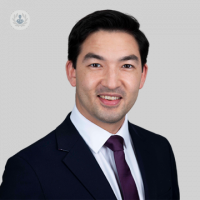When should skull base tumours be removed?
Escrito por:Hearing difficulties. Balance problems. Double vision. Do these symptoms ring a bell? If so, you might need to undergo tests to see if you may have a malignant skull base tumour.
Read on to find out what exactly skull base tumours are, what causes them, and how they are removed, as expert Gamma Knife radio surgeon and consultant neurosurgeon, Mr Patrick Grover, provides us with an informative guide in our latest article.

What are skull base tumours?
Skull base tumours are basically tumours that grow in the brain, but really around the base of the brain. So, you can split brain tumours into those that grow in the brain substance itself, and the ones that grow at the base of and around the brain.
What causes skull base tumours?
The majority of skull base tumours are benign. The reason that they are important is because they grow slowly and approach the critical nerve vessels, and as a result, cause symptoms.
The exact cause is not known. There are certain genetic conditions that can be associated with skull base tumours, but the majority of these tumours appear with age, and we are not entirely sure why some patients get them.
What do skull base tumours feel like? Are there early signs people should look out for?
Yes. For example, the vestibular schwannoma is a common skull base tumour that I deal with on a regular basis, and the key sign of this particular tumour is associated with balance problems, hearing loss, and ringing in the ears.
Hearing tests and an MRI scan will then be carried out for a full diagnosis. Patients also might experience a droopy eyelid, double vision, or a drooping of the face. These are the early specific signs to watch out for.
Are there different types of skull base tumours?
The most common two categories are meningiomas and vestibular schwannomas. The meningiomas form on the covering of the brain and around the base of the skull. These tumours grow very slowly, but as they grow slowly, they can get to quite big sizes, which is when they require medical intervention.
The vestibular schwannoma grows on the hearing and balance nerve specifically. These tumours grow slowly, and the treatment options are quite similar to meningiomas, such as radiation treatment, surgical intervention, and careful monitoring.
How are skull base tumours removed? Should malignant tumours be removed?
The first thing that we always do for these tumours is perform a repeat MRI scan, unless it is extremely large and symptomatic. Some of these tumours never actually grow, so, in these cases, a MRI scan would be carried out every six months, and might never actually require any treatment.
Stereotactic radiosurgery is used to treat small tumours that are continuously growing. Gamma Knife radiosurgery is a very focused radiation-based treatment that is given over the course of one single day.
A frame is fitted onto the brain under local anaesthetic, which allows us to focus the radiation very specifically at the tumour and avoid radiation going to the rest of the brain. This does not remove the tumour, but rather controls the growth. It is a fantastic treatment option for small tumours that patients obviously don’t want to get any bigger.
If you have a large tumour that is compressing structures and causing significant symptoms and swelling, surgery would definitely be required. Between 10 and 20 per cent of skull buse tumours will be removed.
In terms of removing the tumours, there are many different ways of removing the tumours depending on where the tumour is. The resection might be performed through the ear, at the back of the skull, through the side of the skull, or through the nose.
Mr Patrick Grover is a highly esteemed and experienced London-based Gamma Knife radio surgeon and consultant neurosurgeon. If you are suffering from some of the symptoms outlined above, consult with him today via his Top Doctors profile to book a consultation with him.


